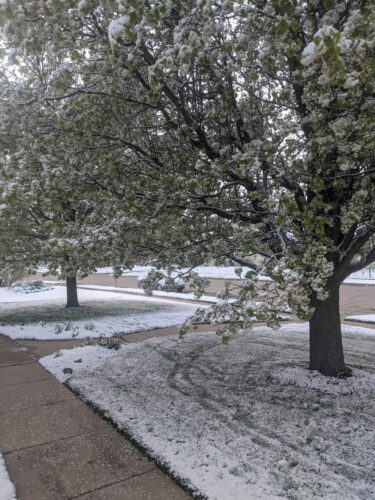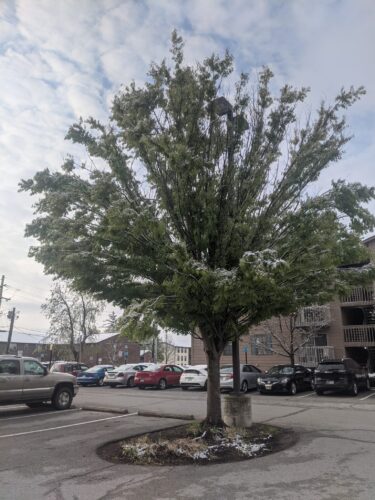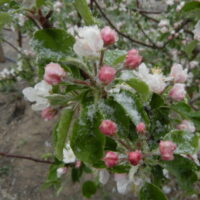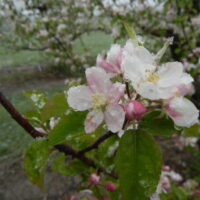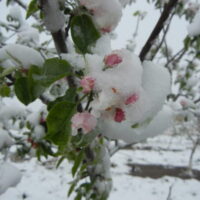 Purdue University - Extension - Forestry and Natural Resources
Purdue University - Extension - Forestry and Natural Resources
Got Nature? Blog
Purdue Landscape Report: The hard freeze April 20th & 21st had many homeowners concerned about their perennial and annual plants in their landscape. For the vast majority of perennial plants, there aren’t many issues long-term of concern. Some foliage and flowers have significant damage, but the plants will recover, and possibly release new vegetative buds in severe cases. The plants that suffered the most damage, and in some cases death, are the annuals planted by impatient landscapers and gardeners. Planting annuals prior to the frost-free date (May 10th in central Indiana) will more than likely cause a replant to occur.
In addition to the potential stress from the temperatures, many trees received broken limbs due the combined weight of the leaves/flowers and snow load.
If you maintain a client’s fruit trees (i.e. apples), there may be a significant impact on fruit production. The Purdue Meigs Horticultural Research Farm, located about eight miles south of the West Lafayette campus, recorded a low temperature of 22o F on April 21st. Dr. Peter Hirst, pomologist, indicated that at the current stage of flowering a temperature of 25o F might result in a 90% bud kill. Since there was a significant snowfall, the hope is that there was some moderation in temperatures.
Plants that have been stressed due to cold temperatures should be closely monitored over the growing season. Don’t prune ‘dead’ portions until you allow more buds to break. Chances are the early foliage was dropped and new leaves will soon emerge. Be sure to provide adequate moisture to assist in recovery. Currently about half of the state is in the beginning stages of drought, so be sure to provide irrigation now if your area is dry. Always remember that too much water can be just as detrimental as too little water.
The Indianapolis Star published an article on the extreme low temperatures.
Resources
Purdue Landscape Report
Tree Installation for the Landscape, Video, Purdue Extension – Forestry and Natural Resources YouTube Channel
Effects of Cold Weather on Horticultural Plants in Indiana, The Education Store, Purdue Extension resource center
Winterize Your Trees, The Education Store
What do Trees Do in the Winter? , Got Nature? Blog, Purdue Extension – Forestry and Natural Resources
Kyle Daniel, Nursery & Landscape Outreach Specialist
Purdue Horticulture and Landscape Architecture

Recent Posts
- Report Spotted Lanternfly – Purdue Landscape Report
Posted: April 10, 2024 in Alert, Forestry, Invasive Insects, Plants, Wildlife, Woodlands - Declining Pines of the White Variety – Purdue Landscape Report
Posted: in Alert, Disease, Forestry, Plants, Wildlife, Woodlands - Are you seeing nests of our state endangered swan? – Wild Bulletin
Posted: April 9, 2024 in Alert, Forestry, How To, Wildlife - Cicadas in Spring! – Purdue Landscape Report
Posted: in Forestry, Plants, Safety, Wildlife - New Deer Impact Toolbox
Posted: April 7, 2024 in Forestry, Land Use, Plants, Publication, Safety, Wildlife, Woodlands - 2024-25 Fishing Guide now available – Wild Bulletin
Posted: April 4, 2024 in Alert, Aquaculture/Fish, Aquatic/Aquaculture Resources, How To, Ponds, Wildlife - Help Research Chronic Wasting Disease – Wild Bulletin
Posted: April 3, 2024 in Disease, Forestry, How To, Safety, Wildlife, Woodlands - Indiana Reptiles and Amphibians – IFWOA Webinar
Posted: April 1, 2024 in Forestry, How To, Webinar, Wildlife, Woodlands - Birding through the Seasons – IFWOA Webinar
Posted: in Forestry, How To, Webinar, Wildlife, Woodlands - Look Out for Invasive Carp in Your Bait Bucket – Wild Bulletin
Posted: March 31, 2024 in Alert, Aquaculture/Fish, Aquatic/Aquaculture Resources, Invasive Animal Species, Wildlife
Archives
Categories
- Alert
- Aquaculture/Fish
- Aquatic/Aquaculture Resources
- Ask the Expert
- Christmas Trees
- Community Development
- Disease
- Drought
- Forestry
- Forests and Street Trees
- Gardening
- Got Nature for Kids
- Great Lakes
- How To
- Invasive Animal Species
- Invasive Insects
- Invasive Plant Species
- Land Use
- Natural Resource Planning
- Nature of Teaching
- Plants
- Podcasts
- Ponds
- Publication
- Safety
- Timber Marketing
- Uncategorized
- Urban Forestry
- Webinar
- Wildlife
- Wood Products/Manufacturing
- Woodland Management Moment
- Woodlands
